The fire control devices of the Soviet and German tanks of the Second World War. Myths and Reality
To begin with, it is necessary to understand why what optical instruments are needed in a tank and how they work in principle. At the same time, I’ll just make a reservation that the viewing slot in the armor of the tank will not be accepted by me for the “optical device”. Even if it is closed by a bulletproof triplex - this is just an observation slot for a direct view - no more. So, in order to destroy a target, a tank must first detect and identify this target. Only after the target is detected and identified as an “enemy”, does the tank need to make an accurate guidance on it weapons and make a shot. What will be further is already beyond the scope of our study. That is, the process of preparing tank weapons for hitting a target is divided, in fact, into only two main components:
1. Target detection
2. Targeting.
And the sooner these two operations are completed, the more likely our tank will be to defeat the enemy. Thus, the optical instruments of the tank are quite specifically divided into two main groups:
1. observation instruments / complexes / panoramas, giving a wide field of view for reviewing the terrain and instruments for detecting the target by the tank crew;
2. optical and infrared sights, with a large magnification, but a small angle of field of view for accurate targeting. Guidance drives and stabilizers can also be assigned to this group, since they determine the speed and accuracy of targeting the detected target of the tank gun.
In accordance with this approach, the functional tasks of the tank crew members are formed. In some tanks, the task of detecting and targeting weapons was solved by one person - the tank commander. Accordingly, he alone served the instruments of both functional groups. These include Soviet tanks: T-34 samples of the 1939, 1941 and 1943, and German Pz.Kpfw I and Pz.Kpfw II.
But still most of the designers of tanks, rightly believing that such a scheme is not optimal, decided to functionally divide the duties of the crew members. The task of the commander now came down only to detecting the target and giving target designation to the gunner, as a result of which he himself began to operate only with the instruments of the 2 group. The task of hitting the target, that is, pointing the weapon at the target and firing a shot, now fell on the gunner-operator with the 1-group devices. The task of communication and command control at first was solved by an individual person - a radio operator (as a rule, he combined the task with the function of a machine-gunner).
This principle, later known as the "hunter-shooter", was implemented on Soviet tanks of the KB series of all brands, T-34-85 mod. 1944 and subsequent combat vehicles. The Germans have this “innovation” (in quotation marks, because in the military navy a similar scheme in its essence was in effect, almost from time immemorial) was introduced on the light tank Pz.Kpfw II and subsequent models.
So what exactly are these devices on the Soviet and German cars of those times? I will give only some of them as examples. Of course, an attentive reader may find that other sights were set on the KV-1 or T-34. But the fact is that as the optics of the Soviet tanks were improved, more and more modern sights and instruments were placed on vehicles of various years. There is no possibility to list them all and will only lead to confusion. Therefore, I give only some typical modifications.
So let's compare in order and in stages of war.
1941 year
All tanks are qualitatively manufactured in peacetime, by highly qualified specialists and with all the necessary resources.
Heavy tank KV-1 (crew 5 people)
The aiming gunner had two sights:
- TMFD-7 telescopic sight (magnification 2,5x, field of view 15 °),
- periscope sight PT4-7 (magnification 2,5х, field of view 26 °),
- for shooting from course and stern 7,62mm machine guns DT used riflescopes PU,
- to illuminate the target in the dark a searchlight was installed on the gun mask.
The commander for target detection had:
- commander's panorama PT-K,
- 4 periscopic observation devices around the perimeter of the tower.
In addition, there were two reticle in the sides of the tower.
The driver had at his disposal:
- 2 periscopic observation device (on some tanks one) and a viewing slot located on the VLD of the hull in the center.
Guidance guns horizontally electric, vertically mechanical drives. Stabilization is absent. The number of daylight optical devices - 11. Night optical devices - 1. Sighting slits - 3. Commander's turret is missing. For shooting from closed positions there was a side level. The peculiarity of the tank is that domestic designers immediately followed the path of creating a specialized observation complex for the commander, rightly deciding that the primitive commander's turret with narrow reticle along its perimeter is an anachronism, as through these slots there is a poor overview. A very small sector is seen through each concrete slot, and when moving from one slot to another, the commander temporarily ignores the situation and its landmarks.
It is regrettable to admit that the commander's device PT-K of the KB-1 tank in this regard was also far from perfect, although it allowed us to continuously observe the entire sector in 360 degrees without taking our eyes off the situation. The principle of "hunter shooter" in the tank is implemented. Here is a general assessment of the KB-1 tank instruments by the Americans: “The sights are magnificent, and the viewing instruments are rough but comfortable. The field of view is very good ... "[1]. In general, for 1941, the instrumentation of the KB 1 tank was very good, if not more.
Medium Tank T-34 (crew of 4 person)
The gunner (he is the commander) for targeting had:
- telescopic sight TOD-6,
- to illuminate the target in the dark, a searchlight [2] was installed on the gun mask.
Radio gunner for shooting from the front 7,62-mm machine gun DT used:
- optical sight PU (increase 3x).
The commander (he is the gunner) to detect the target had:
- PT-K commander's panorama (on some tanks it was replaced with a PT4-7 percussion, periscope sight),
- 2 periscopic instrument along the sides of the tower.
The driver had at his disposal:
- 3 periscope observational device.
Guidance guns horizontally electric, vertically mechanical drives. Stabilization is absent. The number of daylight optical devices - 8. Night optical devices - 1. There are no slits. Commander's turret is missing.
As we can see, in terms of the number of optical instruments, the T-34 tank of the 1939-41 release was slightly inferior to the heavy KV-1 tank. But its main drawback was that the principle of "hunter-gunner" was not implemented on this tank. On the T-34 of these releases, the commander combined the functions of the gunner. Naturally, in battle, he could be carried away by the sight of a target through a TOD-6 telescopic sight (magnification 2,5x, angle of view 26 °) and thereby completely lose control over the environment. I think that there is no need to explain what the tank and its crew were at risk at such moments. To some extent, the commander could help the commander in detecting the enemy. Therefore, compared with the heavy KV-1, the T-34 tank of the first releases is still much more “blind”.
The opinion of American experts on T-34 optics: “The sights are excellent, and the viewing instruments are not finished, but very satisfactory. Overall visibility limits are good. ”[1] In general, the instrumentation equipment of the pre-war T-34 tank was quite up to par. Its main drawback is the absence of a gunner in the tank crew.
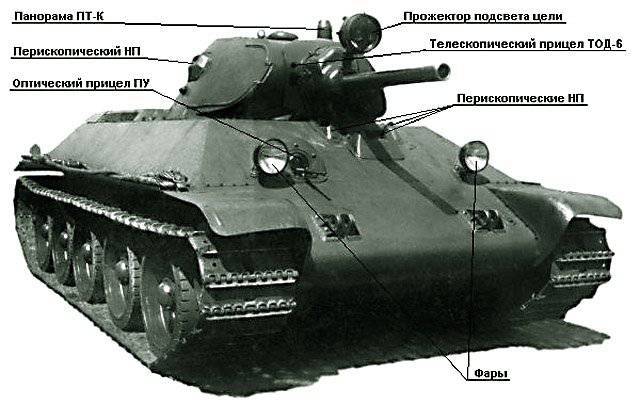
Light tank T-26 (crew of 3 person)
I chose this tank for review for two reasons. First, the T-26 was the main tank of the Red Army in the prewar period and was released in quantities of more than 10000 pcs. At the beginning of World War II, the share of these tanks in the units of the Red Army was still significant. Secondly, despite the rather unsightly appearance, the T-26 was the first Soviet tank, whose fire control system allowed it to conduct effective aimed fire from a turn.
The aiming gunner had two sights:
- telescopic, vertical stabilized sight TOC-1 with a shot resolution block,
- periscope sight PT-1,
- to illuminate the target in the dark, a 2 searchlight was mounted on the gun's mask,
- For shooting from the stern 7,62-mm DT machine gun there was a diopter sight.
The commander (who is also charging) for detecting the target had only two sighting slots along the sides of the tower. He could also use the PT-1 panoramic sight to search for a target. The driver had only a slit.
Thus, the light tank T-26, having sufficiently weak means for detecting a target, had excellent chances to hit this target (if it was still found).
Guidance guns horizontally and vertically mechanical drives. The number of daylight optical devices - 2. The number of night optical devices - 2. Number of sighting slots - 3. Commander's no turret. The idea of stabilizing only the sight in the T-26 tank was undoubtedly more successful than the American approach to the problem of shooting accuracy from the course - stabilization of the whole gun with dependent mechanical stabilization of the sight from it. The imperfect and low-power stabilizer VN of the American tank M4 "Sherman" did not allow to precisely hold the cannon on the target, especially when driving on rugged terrain. Still, when the hull oscillated, the hull was still there, since the sight had a mechanical connection with the gun — it lost its purpose and the gunner of this tank. The TOC-1 sight of the T-26 tank confidently held the target in the most difficult conditions. When the gunner pressed the shooting button, the shot occurred at the moment when the axis of the gun was aligned with the axis of the sight, and the target was amazed. The TOC-1 had an 2,5x magnification, the 15 ° field of view and was designed for aimed shooting at a distance of up to 6400 m. The PT-1 sight had the same magnification, the 26 ° field of view and the 3600 m aimed fire range. On the whole, it is implemented rather doubtfully, since the tank commander had a very limited set of means for detecting a target and was also distracted by the reloading of the gun.
It should be noted that due to low qualifications and danger in circulation, the Soviet tank crews usually turned off the stabilizer on the Sherman’s MNNUMX lend-lease tanks. Also for the illiterate soldiers' crews of the Red Army, there was a variant of the T-4 tank with a conventional TOP telescopic sight, similar in characteristics to the stabilized TOC-26 sight.
Light tank Pz.Kpfw III Ausf. G (crew 5 people)
The gunner for targeting had:
- telescopic sight TZF.Sa (increase 2,4x).
The commander to detect the target had 5 sighting slots in the commander's turret. The charger could use 4 reticle on the sides of the tower.
The driver mechanic possessed:
- rotary periscopic viewing device KFF.1 and 2 with a reticle in the tank body front and left.
One radio slot in the right side of the case was also available to the radio operator shooter. For shooting from the course machine gun, the radioman-shooter used the same reticle.
Guidance drives horizontally and vertically mechanical. The number of daylight optical devices - 2. The number of night optical devices - 0. Number of sighting slots - 12. Commander's tower there.
It is surprising more than a scant equipment of this German tank with any optics in general. Especially bright dissonance is obtained when compared with Soviet tanks. For example, KB-1 already had 11 optical devices (!) Against 2 of the “troika”. At the same time, the latter simply has a huge number of sighting slots - as many as 12 pieces! They, of course, improved the view from the tank, but weakened its protection and were themselves a vulnerable place in the tank, while posing a danger for the tank crews using them. The commander of this tank was generally deprived of any kind of optical surveillance devices, except, perhaps, his own binoculars. Plus there was a commander's turret, however, again, the commander's turret did not have any instrumentation equipment, and after five narrow slits it was obvious that it was very bad.
Here I consider it nevertheless necessary to give a detailed explanation of why the sighting gap for a full-fledged optical observational device I do not consider. In the case of a periscopic device, a person conducts observation indirectly, while being protected by armor. The very same exit pupil of the device is located much higher - very often in the roof of the hull or tower. This allows you to make the mirror area of the device large enough and thus provide the necessary field of view and viewing angles. A bullet or a fragment in the device will in the worst case only lead to the failure of this device. In the case of the sighting gap, the situation is much sadder. This is just a narrow slot, cut in the armor, directly through which a person conducts observation. Obviously, this design is vulnerable and potentially dangerous. The consequences of a bullet or projectile falling into the slot can be different - from damage to the observer's organs of vision, or to the failure of the tank. In order to minimize the likelihood of bullets or shrapnel entering the viewing slot, its dimensions are minimal, which, in combination with thick armor, narrows the field of view very much through this gap. In addition, to protect the eyes of the observer from bullets or fragments accidentally caught in the gap, it is closed from the inside by thick armored glass - triplex. So a person cannot cling to the sighting slit - he is forced to look through the slit from a certain distance determined by the thickness of the triplex, which naturally narrows the viewing sector even more. So, no matter how imperfect the periscopic observation devices of the KV-1 and T-34 tanks were, they were a priori an order of magnitude better than the sight slits of German tanks. This deficiency was somewhat offset by the tactics of the German crews, but more on that below.
Medium tank Pz.Kpfw IV Ausf. F (crew 5 people)
The gunner for targeting had:
- telescopic sight TZF.Sa.
The commander to detect the target had 5 sighting slots in the commander's turret. The gunner and loader could use 6 reticle located on the frontal plate of the tower (two), on the sides of the tower (two) and on the side hatches of the tower (also two).
The driver had:
- rotary periscopic device KFF.2 and a wide viewing slot. Radioman-shooter had two viewing slots.
As a result: the horizontal pointing drive is electric, vertical mechanical, there is no stabilization, the commander's turret is there, the number of daytime optical devices is 2, the number of nighttime optical devices is 0, the number of sighting slots is 14 (!).
Thus, we can say that at the beginning of the war, our tanks of peacetime still had incomparably richer and more diverse equipment with optical instruments than their German opponents. At the same time, the number of archaic reticule slots was minimized (KV-1, T-26), or they were completely absent (T-34). The lack of a commander's turret is explained by its uselessness on the KB-1 and T-34 tanks (in order not to increase the height of the tank) of the PT-K commander’s specialized optical observation instruments, which provide all-round visibility, for target detection.
1943 year
This period is associated with the extremely difficult situation of the USSR. The huge losses at the front and the seizure by the enemy of vast areas of the country could not but affect the volume and quality of the products. Changes were made to the design of Soviet tanks, mainly aimed at simplifying and cheapening their design. In the factories at the machine tools there were no longer skilled workers, and often women and children. Crews of tanks were also recruited from people who did not have sufficient training in this matter, which, in combination with a not very competent organization of command and control, gave rise to expressions like: “Tank fights an average of five minutes,” etc.
Naturally, this left an imprint on the equipment and appearance of the Soviet tanks of this period. Speaking specifically about optics, the Soviet tanks lost their optical searchlight to illuminate targets at night, as in the conditions of intense shelling, it very quickly became unusable. He was abandoned on most tanks at the beginning of the war.
Optical, periscopic observation devices on the most massive T-34 tank in some places were replaced with simple reticle. Abandoned riflescopes for machine guns, replacing them with dioptric ones. Explicit regression, but there was no other way out. Often a tank was deprived of even the sights and instruments it needed in battle. In this sense, the Soviet 1942-43 release tanks were far from their own pre-war relatives.
At the same time, it is impossible not to mention the correct conclusions made by the Soviet military and designers. First, a high-speed heavy tank KV-1С (speed up to 43 km / h on the highway) was created. And soon, in response to the appearance of the German heavy tank Pz.Kpfw VI Tiger, we had a new model, the KV-85, with a powerful and accurate 85-mm D-5T cannon, updated sights and fire control devices in a completely new spacious turret . This highly mobile (relatively, of course) tank with powerful weapons, excellent optics and protection is better than the German Panther tank in capable hands turned out to be a very effective means of fighting enemy tanks of any type (the only exception was the Royal Tiger).
The main medium tank T-34 was also modernized, which also received new instruments and a commander's turret. German industry, although it suffered from bombing, was still able to produce tanks quite comfortably and efficiently in the period described, not really saving on them.
Heavy tank KV-1С (crew 5 people)
The aiming gunner had two sights:
- telescopic sight 9Т-7,
- periscope sight PT4-7.
The commander for target detection had:
- 5 periscope instruments in the commander's cupola,
- For firing from the stern 7,62-mm DT machine gun, the commander used a diopter sight.
Charger to monitor the environment had:
- 2 periscopic device in the roof of the tower. In addition, at his disposal were 2 reticle in the sides of the tower.
The radioman-gunner for observation had only a diopter sight of a course 7,62-mm DT machine gun.
The driver observed the situation through:
- periscopic device in the roof of the hull. In addition, he had a sighting gap in the center of the VLD case.
The drive guidance horizontally electric, vertically - mechanical. Stabilization is not. Commander's tower there. The number of daylight optical devices - 10. The number of night optical devices - 0. Number of sighting slots - 3. The principle of the hunter-gunner is implemented in the tank.
Heavy tank KV-85 (crew of 4 person)
The aiming gunner had two sights:
- 10T-15 telescopic sight (magnification 2,5x, field of view 16 °),
- periscope sight PT4-15.
There was a side level for shooting from closed positions.
The commander used to detect the target:
- periscopic rotating device MK-4 giving 360 ° viewing sector. 6 sighting slots in the commander's pinnacle were available as a backup surveillance tool. For firing from the stern 7,62-mm machine gun DT was used optical sight PU.
Charger led the observation through:
- periscopic device MK-4. In addition to it, there were 2 reticle in the sides of the turret.
Mechanic driver used:
- 2 of the periscopic device MK-4 and the reticle in the center of the VLD housing.
The drive guidance horizontally electric, vertically mechanical. Stabilization is not. Commander's tower there. The number of daylight optical devices - 7. The number of night optical devices - 0. Number of sighting slots - 9. The principle of the hunter-gunner is implemented in the tank.
A distinctive feature of the tank was that its spacious fighting compartment provided good living conditions and ease of maintenance with an accurate and fast-firing 85-mm cannon D-5Т-85, which easily penetrated the frontal armor of the Tiger from the distance 1000-1200 m, that is on the distance of the DPV [3]. At the same time, the commander of the tank to get targets received a quality wide-angle periscopic prismatic MK-4 device, which allowed him to continuously trace the entire circular sector with a wide field of view without tearing off his gaze. Thus, the commander of the KV-85, unlike the commanders of German vehicles, did not need to open the hatch and poke his head out of the tank, putting himself at risk (domestic snipers, for example, followed the commander's hatches of German tanks).
In terms of quality and quantity, the KV-85 was equipped with optics at least as good as any foreign tank, including the Tiger with the Panther. It was precisely the PT-K and MK-4 devices that became the embryos of the sighting and observation commander complexes of the Soviet post-war main battle tanks.
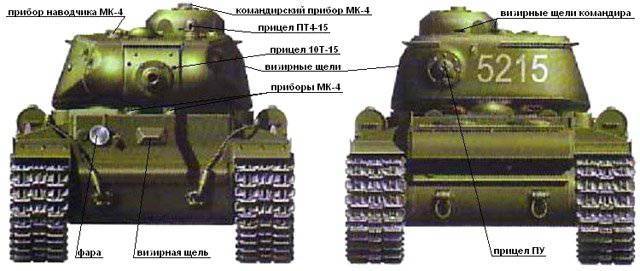
Medium Tank T-34 (crew of 4 person)
This is the most massive domestic tank. In 1943, the year was already produced in six factories with a multitude of related enterprises, and therefore is a real “designer for adults”. Despite the huge number of released units (more than 60 000 units), it is unlikely that even two completely identical tanks will be able to be found. Part of the enterprises engaged in the production of T-34, during the war years were reoriented to the production of this already in the course of the war and were initially not engaged in the production of such products. Naturally, the quality of the product and its good configuration, as was the case in the prewar years, could easily be forgotten in 1942. T-34 tanks were produced at this time extremely "stripped" and simplified. The build quality of components and assemblies made it possible to reach them from the factory gates to the battle site. Despite such a sad situation, here too, there was a place for some innovations introduced into the design of this popular, mass tank.
The gunner (he is the commander) had two sights for aiming at the target:
- telescopic sight TMFD-7,
- periscope sight PT4-7.
The commander (he is the gunner) to detect the target had:
- periscopic device MK-4 on the commander's turret. As a backup observation tool, there were 5 sighting slots around the perimeter of the commander's turret.
Charging at his disposal had:
- periscopic device MK-4. In addition to this, there were 2 sighting slots along the sides of the tower.
The driver led the observation through:
- 2 periscopic device located in its hatch.
The radioman-gunner had no means of observation, except for the diopter sight of his machine gun.
Horizontal pointing electric drives, vertically mechanical. Stabilization is not. Commander's tower there. The number of daylight optical devices - 6. The number of night optical devices - 0. Number of sighting slots - 7. The principle “hunter-shooter” is not implemented in the tank and this is one of its serious drawbacks.
One person (commander, gunner) was unable to maintain the instruments of both functional groups and it was very difficult for him to divide the contours of attention into these two positions. Usually the hunting excitement made the commander on duty look into the TMFD-7 telescopic sight. At the same time, he did not care about the commander's turret with the specialized device MK-4 installed in it. The search for the target was easier for the commander-gunner through the PT4-7 periscope sight located nearby. This scope had a field of view of 26 ° and could rotate, thus providing a viewing angle of 360 °. For this reason, the commander's turret on the T-34-76 did not take root, and it was not installed at all on many tanks of this type. The poor quality of the glass used for optics of the tank reduced visibility even more.
Here is the opinion of American experts about the optics of the X-NUMX T-34 tank of the year: “The design of the sight was recognized as beautiful, even the best in the world from the famous American designers, but the quality of the glass left much to be desired” [1942]. However, already in the middle of 4, the Izyumsk optical glass plant (evacuated in 1943) managed to raise the quality of its products to world standards. At the same time, by their design, domestic sights have always been at least in the “top three”.
Medium tank Pz.Kpfw IV Ausf. H (crew 5 people)
The gunner for targeting had:
- telescopic sight TZF.Sf.
The commander to detect the target had 5 sighting slots in the commander's turret.
The driver had:
- rotary periscopic device KFF.2 and a wide viewing slot.
Radioman-shooter had only dioptricheskom gunpoint.
Horizontal guidance drives are electric (mechanical on some tanks), mechanical vertical, no stabilization. Commander's tower there. The number of daylight optical devices - 2. The number of night optical devices - 0. Number of sighting slots - 6.
The design of the tank was modified to maximize the firepower and security. At the same time, the equipment of the tank with instruments and optics was greatly simplified. With the installation of onboard protivokumulyativnyh screens had to eliminate the reticle in the sides of the hull and turret. On the part of the tanks they also refused the electric drive of the turret rotation! Then they abandoned the periscopic device of the driver’s mechanic KFF.2, so that all the optics of this tank began to be only one gunner’s sight.
Heavy tank Pz.Kpfw VI. Ausf E "Tiger" (crew 5 people)
The gunner for targeting had:
- telescopic sight TZF.9b (magnification 2.5х, field angle 23 °). To observe the terrain, he could use the reticle in the left side of the tower.
The commander used the 6 reticle in the commander's turret to detect the target. Charger could use:
- periscopic device in the roof of the tower and the reticule gap in the right side of the tower.
Mechanic driver used:
- reticle and fixed periscope device in the hatch cover.
The radio operator-machine gunner used:
- telescope KZF.2 7,92-mm machine gun and fixed periscope device in the hatch cover.
As a result, the tank had horizontal and vertical vertical guidance drives, there is no stabilization, there is a command tower, the number of daytime optical devices is 4. The number of night optical devices - 0. Number of sighting slots - 9. The principle of the hunter-gunner is implemented in the tank.
As can be seen, the difference of this tank from its lighter counterparts is basically only in the fact that part of the auxiliary sighting slots (charging, arrow, mechanics) was replaced with fixed periscopic instruments. At the same time, the commander had at his disposal to search for targets the same notorious commander's cupola with narrow and blind "reticule slots", which in Soviet tanks at that time was already used as a backup (the only exception was KB-1C).
The main advantage of this tank and its one of the main disadvantages: hydraulic drives horizontal and vertical guidance. This allowed the gunner, without physical effort, to point the gun at the target accurately. But there were also disadvantages: the extremely slow rotation of the tower and the high fire risk of the entire system. Soviet tanks had an electric turret turning mechanism (BCH) and manual vertical guidance. This ensured a high speed of rotation of the turret and allowed them to very quickly transfer the cannon to the newly discovered target, but it was difficult to take aim right away from unaccustomed use. Inexperienced gunners had to manually adjust later.
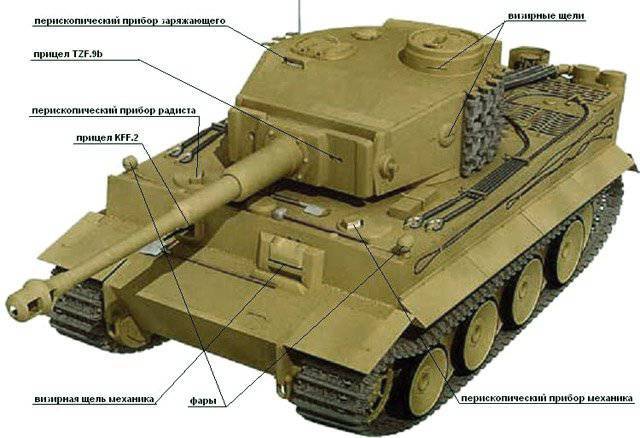
1945 year
The period can be described as extremely difficult for the German industry. Nevertheless, the agonizing "Third Reich" frantically tried to find a miracle weapon capable of reversing the course of the war. Not having the ability to produce armored vehicles on the required scale, comparable to the volume of production in the USSR and the USA, the Wehrmacht made the only possible decision, as it was then believed, to create a complex and expensive, but at the same time, capable of surpassing opponents pattern [5]. To exceed the "head", by the way, and failed. Nevertheless, this period is interesting the emergence of such monstrous structures as the heavy tank "Royal Tiger", self-propelled gun "Yagdtigr", super-heavy tank "Maus". More or less viable instance was only a heavy tank Pz.Kpfw VI Ausf. In "The Royal Tiger" or "Tiger II". It is also necessary to note the appearance on the battlefield of a new, heavy tank Pz.Kpfw V "Panther" and self-propelled gun "Jagdpanther", created on its base.
Unlike Germany, the flywheel of Soviet power, including industrial power, continued to spin. A new heavy tank, the EC-2, was created. The tank was armed with an exceptionally powerful X-NUMX-mm D-122T rifled gun, which easily penetrated the frontal armor of any German tank at all distances of a tank battle of that time. The EC-25 was not a specialized anti-tank tool - for this role, the rate of its weapon was clearly insufficient. It was a heavy breakthrough tank. However, in the case of a duel with a German tank, IS was required to get through it only once. “One or two or two”, as a rule, made the death of any German tank instant and bright. In accordance with these specifications, the tactics of using the IS-2 tank against enemy armored vehicles were developed. Now our tank crews didn’t need to approach the German “cat” almost point-blank — you could not worry about the penetrating power of the D-2T. On the contrary, it was necessary to notice the enemy as soon as possible and, turning his forehead to him, start quietly shooting him from a distance at which the Panther 25-mm cannons and the Tigers 75-mm cannon were still weak before the heavy armor of the tank EC-88.
To increase the range of effective fire of the powerful gun for the EC-2 tank, a new articulated, telescopic, monocular sight TSH-17 was developed, which had an 4 multiple magnification.
Tank EC-2 was created in 1943 year. 1944 improved it. And in 1945-m was created super-powerful heavy tank EC-3, for many years determined the path of development of Soviet heavy tanks.
A very successful and efficient heavy tank KB-85 was discontinued (148 tanks KB-85 were released with 85-mm NP D-5T, one KB-100 tank with 100-mm NP D-10T and one KB-122 tank with 122-mm NP D-25T) in favor of the release of the EC-2, and the role of the tank-fighter shifted to a cheaper and more technologically advanced T-34-85. This medium tank appeared in 1944 year on the basis of the famous "thirty-four" early releases. He was very agile, coped well with the German medium machines, though against the Tigers and Panthers, the T-34-85 still passed, with a lower level of booking. The manufacturing quality of the tank has already met international standards. The same can be said about the American medium tank МХNUMX "Sherman" delivered to the USSR according to the Lend-Lease.
Medium Tank T-34-85 (crew 5 people)
This machine is the result of a deep modernization of the T-34 tank. On the extended pursuit, a new spacious tower was installed for three people with reinforced armor. Depending on the modification, the tank could be equipped with X-NUMX-mm D-85T or C-5 rifled guns. Both guns are identical in ballistics. A gunner appeared in the crew (finally, in 53, the year!), As a result of which the principle of “hunter-shooter” was implemented. Significantly updated instrumentation.
The aiming gunner had two sights:
- TS-16 telescopic sight (magnification 4x, field of view 16 °),
- Periscope panoramic sight PTK-5, as well as the side level for shooting from closed positions.
The commander to detect targets had:
- periscope observation device MK-4 in the commander's turret. As a backup, there were 5 sighting slots in the commander's turret.
The gunner had:
- periscope observation device MK-4 in the roof of the tower.
Shooter for shooting from the course 7,62-mm machine gun DT used:
- telescopic sight PPU-8Т.
The driver led observations through:
- 2 periscopic surveillance device in the manhole cover.
For the tank, the STP-C-53 armament stabilizer was developed in the vertical plane, but due to its low reliability it was not introduced [6]. Thus, the horizontal pointing drive is electric, vertically - mechanical. Commander's tower there. Stabilization is not. The number of daylight optical devices - 7. The number of night optical devices - 0. Number of sighting slots - 5. The principle of the hunter-gunner is implemented in the tank.
Heavy tank IS-2 (crew of 4 person)
The aiming gunner had two sights:
- TS-17 telescopic sight (magnification 4x, field of view 16 °),
- periscope sight PT4-17. Side level for shooting from closed positions.
The commander to detect targets had:
- periscopic rotating device MK-4 giving 360 ° viewing sector. As a backup surveillance tool, there were 6 reticle in the commander’s turret,
- PPU-8T telescopic sight was used for firing from aft 7,62-mm DT machine gun,
- collimator sight K8-T - for firing from an antiaircraft 12,7-mm machine gun DShK.
Charger led the observation through:
- periscopic device MK-4. In addition to it, there were 2 reticle in the sides of the turret.
Mechanic driver used:
- 2 of the periscopic device MK-4 and the reticle in the center of the VLD housing.
Guidance guns horizontally electric, vertically - mechanical. Commander's tower there. The number of daylight optical devices - 8. The number of night optical devices - 0. Number of sighting slots - 9. Stabilization is not. The principle of the hunter-gunner is implemented in the tank.
Speaking about the optics of the Soviet tanks of the last year of the war, it should be noted that some of them were equipped with active infrared night observation devices of the driver. At that time, these domestic devices were still very imperfect and provided a range of vision in complete darkness no more than 20-25 meters. Nevertheless, they allowed the driver mechanics to drive the tank quite confidently at night without switching on the usual headlights unmasking them. Since these devices were used only for controlling the tank, and not for firing from it, I did not introduce them into the configuration of the Soviet tanks considered in the article.
Heavy tank IS-3 (crew of 4 person)
This super-powerful tank was created at the very end of the war on the basis of components and assemblies of the heavy tank EC-2 and did not participate in hostilities with Germany. EC-3 had a very perfect and thoroughly calculated ballistic form of the hull and tower. With course and side angles, almost any point of contact with this tank gave a rebound. All this combined with a crazy thick armor (tower in a circle - up to 220 mm!) And a small body height. Not a single tank of that time could do anything with the EC-3 armor, whose own 122-mm gun quite confidently took, in general, any tank of that time at all distances (of course, the “Royal Tiger” was worse) was quite permeable). Strengthened and firepower. The commander of this tank for the first time in the world received an automatic target designation system for the gunner.
This innovation turned out to be very useful and, in a slightly modified version, is also used on modern tanks. The advantage of a tank equipped with a similar system is obvious and this is why. If in battle there are two tanks, similar in terms of performance characteristics, then the victory is usually won by the one who was able to find the enemy first. I have already started discussing this topic at the beginning of the article, and now I will summarize its logical conclusion. If both tanks saw each other at the same time or almost simultaneously, then the one who first opens aimed fire and hits the enemy will win. The time from the moment when the target is detected to the moment when the aimed fire is opened on it is called the “response time to the target”. This time includes:
1. The time required for loading the gun with the required type of ammunition and preparing the gun for firing.
2. The time needed for the gunner to see the target detected earlier by the commander in the lens of his sight.
3. Time needed to the gunner in order to accurately aim and shoot.
If everything is clear with the first and third paragraphs, then the second one needs clarification. In all previous tanks, the commander, after he discovered the target through his instruments, began to explain to the gunner with a voice (through TPU) and where exactly she was. At the same time, while the commander can find the right words to describe the target, while the gunner understands where she is, while he can “find” her with his own sight, which has a relatively narrow field of view ... All this took precious seconds, which in some desperate situations became fatal for tankers.
On the new tank EC-3 everything was different. The commander, having detected the target through his command-type prismatic device MK-4 (later replaced by the commander's periscopic, stereoscopic device TPK-3 having the variable 1x – 1x multiplicity of increase) on the command-line prismatic device, did not say a word to the gunner, simply pressed the button. The turret automatically turned in the direction where the MK-5 commander's device looked and the target was in the field of view of the gunner's sight. Next - a matter of technology. Everything is easy and simple - I saw the target, a couple of seconds and the gunner was already aiming at it.
Another feature of the tank EC-3 - the refusal of the commander's turret, which gave a "great overview" of the area according to some historians of BTVT. From the previous explanations it is clear that in the Soviet tanks the commander was looking for a target through a special commander's device: PT-K or MK-4 - it does not matter. It is important that the reticule slots in the commander's turret were left as a backup tool (in the event of a commander's instrument damage, for example) and in reality they were hardly used. The review through them was not comparable with the review through the MK-4. So we decided on the EC-3, in order not to increase the weight and height of the car, to completely abandon this anachronism (as it turned out, it’s still early). The consequence of this was a large dead zone commander device in the right-down direction (especially it was felt when the tank was tilted to the left side). Gone are the holes in the armor of the tank.
So, EC-3. The gunner for targeting had:
- telescopic sight TSH-17.
To observe the terrain, he had:
- periscope observation device MK-4. There was a side level for shooting from closed positions.
The commander used to detect targets:
- periscopic observation device MK-4 with automated target designation system TAEN-1,
- collimator sight K8-T for firing from 12,7-mm anti-aircraft machine gun DShK.
Charger had:
- periscope observation device MK-4 in the roof of the tower.
The driver in the combat position led the observation through:
- periscope observation device MK-4.
In the stowed position, he led the tank with his head out of the hatch.
The advantageous distinctive feature of the EC-3 was the so-called “pike nose”, where the VLD consisted of three armor plates angled to each other. In addition to enhanced projectile resistance, such a nose shape allowed the mechanic to the driver of the EC-3 tank to easily climb and crawl out of the tank while the gun was turned right on the nose and its zero angle of elevation. And this despite the tower pushed to the bow. It would be great if the creators of modern Russian main battle tanks would turn their gaze to this wonderful design. And it will not be necessary to keep the tower turned all the way to the side and the driver-mechanics would make life easier.
Horizontal pointing electric drives, vertically mechanical. Stabilization is not. Commander's no turret. The number of daylight optical devices - 6. The number of night optical devices - 0. Number of sighting slots - 0. The principle of the hunter-gunner is well implemented in the tank.
Later, an upgraded version of this EC-3M tank was created, in which sights and fire control devices were improved, night-vision devices were introduced, and the tank’s ammunition assembly was supplemented with new feathered armor-piercing projectiles (BOPS) for the X-NUMX-mm cannon D-122T capable of distance 25 m to pierce along the normal armor thickness 1000 mm.
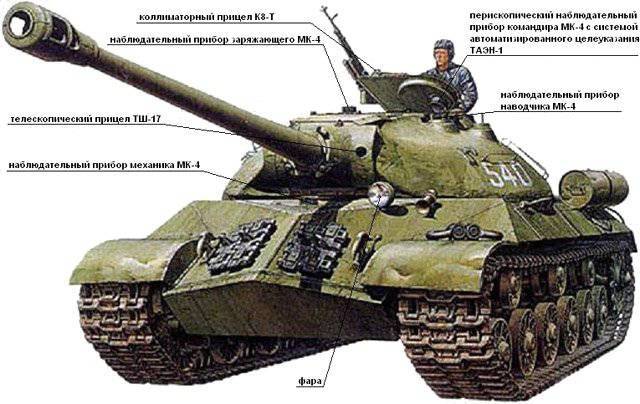
Heavy tank Pz.Kpfw V. Ausf G. "Panther" (crew 5 people)
In fact, according to the German classification, the Panther was a medium tank, but according to our classification everything that was heavier than 40 tons was considered a heavy tank. A "Panther" weighed 46,5 tons. The Soviet approximate analogue of this German "cat" was the KV-85, which was very close to it in its performance characteristics. The Germans turned out to be a pretty good tank, although in its “philosophy” it was an example of a purely German approach to tank design.
The highlight of the Panther was that a small part of the tanks of this type received active infrared night vision devices from the commander Sperber FG 1250. This device was installed on the tank commander’s turret and was not designed for firing, but for detecting targets by the commander in the dark. It consisted of a convector image and an infrared illuminator designed to illuminate the target with an IR beam. The range of vision of the device at night by modern standards was small - about 200 m. At the same time, the gunner did not have such a device and didn’t see anything at night, just like the gunners of any other tanks of that time. Therefore, he couldn’t conduct aimed fire at night anyway. The shooting was carried out blindly on the verbal prompts of the commander. Similarly, the driver mechanic drove the tank at night, focusing exclusively on the commands of the tank commander. However, even in this form, these devices provided the Panthers with an advantage at night over Soviet and Allied tanks. Naturally, they were much more modern than the first domestic night-time instruments that I mentioned when describing the heavy tank EC-2. The existence of such a “night” version of the “Panther” among the enemy led to some nervousness of the crews of Soviet tanks in the dark.
The gunner for targeting had:
- TZF-12A telescopic sight (had a variable magnification ratio 2,5x-5x and in accordance with this a changing field of view 30 ° -15 °).
The commander to detect targets had:
- 7 periscope observation devices in the commander's cupola,
- active infrared night vision device Sperber FG 1250 (night vision range up to 200 m).
Charging observation devices did not have.
The driver led the tank using:
- rotary periscopic observation device.
Radioman-gunner had:
- telescope KZF.2 7,92-mm MG.34 machine gun and periscope observation device.
Guidance drives horizontally and vertically hydraulic. Commander's tower there. Stabilization is not. The number of daytime optical devices - 10. The number of night optical devices - 2. Number of sighting slots - 0. The principle of the hunter-gunner is implemented in the tank. There was a system of purging the barrel with compressed air, which reduced the gas content of the fighting compartment. Soviet tanks of the time treated only the VU combat compartment.
This tank, in fact, absorbed all the best that German industry could give at that time. The latest modifications of the tank (Ausf F) even put optical rangefinders. The Panthers were a formidable opponent for domestic and American medium tanks (most often encountered on the battlefield). At the same time, its organic flaws are due to the “German” design approach, namely: large dimensions, which, with its mass in 46,5, made its defense worse than the Soviet KV-85 tank of the same mass and much worse than the IS- 2. The apparent discrepancy between the caliber of the 75 mm gun in such dimensions and weight.
As a result, the tank could not withstand combat contact with the Soviet IS-2 heavy tanks. The case of the complete defeat of the Panther 122-mm armor-piercing shell of the EC-2 tank from the 3000 distance is known. The 85-mm KV-85 and T-34-85 cannon also had no problems with this German beast.
It is also interesting to note how the appearance of German tanks changed during the war. The Germans at first were very proud of the convenience of their tanks. Their light and medium tanks started the war and were filled with numerous hatches, hatches, reticle and traffic jams. On the example of "Panther" it is clear that the Germans ultimately chose the path of Soviet designers. The number of holes in the armor "Panther" is minimized. The reticle and the plugs are completely missing.
There were very few nightly versions of the Panther, and they drowned in the mass of their usual, “daytime” twin brothers. However, I found it necessary to elaborate on this model, because otherwise the silence about them can be regarded as playing along with Soviet tanks. I have the courage to claim at least some objectivity.
Heavy tank Pz.Kpfw VI. Ausf V. "The Royal Tiger" (crew 5 people)
This tank was created at the very end of the war in a vain attempt to surpass the advancing Soviet tanks in quality. Naturally, the “German quality” in these tanks no longer smelled. Everything was done very roughly in a hurry (approximately as T-34 in 1942-th year). His 88-mm gun from the Ferdinand self-propelled gun was quite effective, but the tank itself, which is a kind of enlarged Panther, turned out to be as heavy and slow-moving as unreliable. In other words, German designers managed to create a super-heavy tank. A good tank is not. And experienced German tankers still preferred to use the usual "Tigers".
Here are the words of the authoritative German tanker Otto Carius (he fought on Pz.38 (t), “Tigre”, “Jagdtigre”) which according to some information about 150 destroyed tanks and self-propelled guns: “If you are about Konigstiger (Tiger II), then I I don’t see any real improvements — heavier, less reliable, less maneuverable ”[7]. Of course, Otto Carius is partly disingenuous, as he loved his usual Tiger very much. For example, the armor of the “Royal Tiger” does not even compare with the usual “Tiger”, but on the whole its assessment is quite correct.
The “Royal Tiger” gunner for targeting had:
- telescopic sight TZF-9d / l (had a variable magnification 3x – 6x).
The commander to detect targets had:
- 7 periscope observation devices in the commander's cupola.
Charger used:
- periscope observation device in the roof of the tower.
Radioman-shooter enjoyed:
- an optical sight to the 7,92-mm MG.34 KZF.2 machine gun,
- periscopic device in the roof of the hull.
The driver led the observation through a periscope observation device.
Thus, the horizontal and vertical drives are hydraulic, there is no stabilization, there is a commander's tower, the number of daytime optical devices is 11. The number of night optical devices - 0. Number of sighting slots - 0. The principle of the hunter-gunner is implemented in the tank.
In the analysis of the comparative characteristics of sights and instruments of observation of domestic and German tanks, the assembly of tanks with these devices and their functional distribution, the conclusion suggests itself not confirming the widespread opinion about the "high-quality optics" of German tanks and the "poor" sector of the Soviet review. In other words, this is another myth that has taken root repeatedly.
As can be seen from the comparative tables, Soviet tanks initially, even before the war, had on average richer equipment with optics than their German opponents, with the exception of a “fly in the ointment” in the form of a small amount of “Panther” with night observation devices. Where the German tanks had one sight, the Soviet had two. Where Soviet tanks had a specialized commander's device for detecting targets, the Germans treated the primitive turret with narrow reticle. Where the German tanks had reticule slots - the Soviet had periscopic devices.
Let us dwell on some of these positions in more detail.
What are two sights? In battle, the tank sight can easily be, if not broken, then simply smeared with mud. The Soviet gunner could use the second sight, and put the first one in order after the battle in a calm atmosphere. In a similar situation, the German tank turned into an inefficient "punching bag". He had to either be taken out of the battle, weakening his strength for a while, or, right in battle, one of the crew members would crawl out with a rag and wipe it clean. What it could turn around, I think there is no need to explain.
In which the periscope device is better than a simple sighting gap has already been explained above.
Now, regarding the commander devices of the first functional group, that is, intended for the detection of targets. In the matter of creating such observation instruments, and later the commander’s sighting and observation complexes at their base, we were ahead of the Germans for the entire war. Even the pre-war tanks KB-1 and T-34 had a special commander panoramic rotary device PT-K and its modifications. German tanks throughout the war did not have such devices. All models of German tanks for the review of the area by the commander had only commander's turrets, on which, however, the sighting slots were later replaced with X-NUMX-6 periscopic instruments, giving a larger field of view. The commander's turret of the Soviet tanks appeared was, but very soon (on the EC-7) it was abandoned as unnecessary. Thus, the talk about the "excellent" sector of the review of the German tanks do not correspond to reality. The German commanders eliminated this lack of visibility of their tanks in a very simple and original way. If you hear a speech about a large sector of the review of German tanks, then you should first of all be presented with the following pictures:
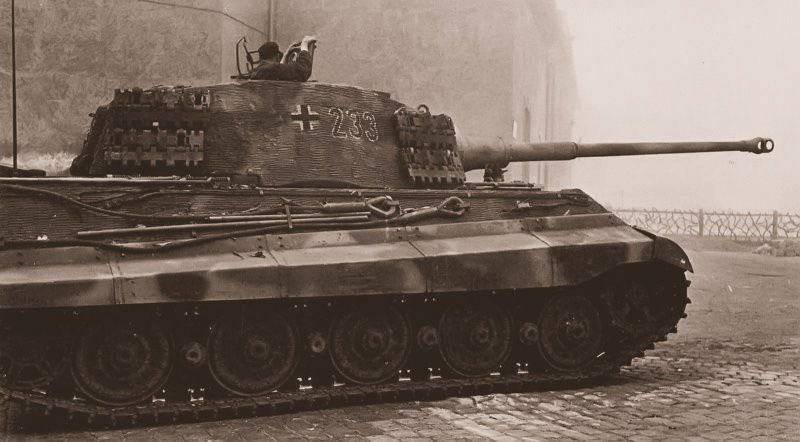
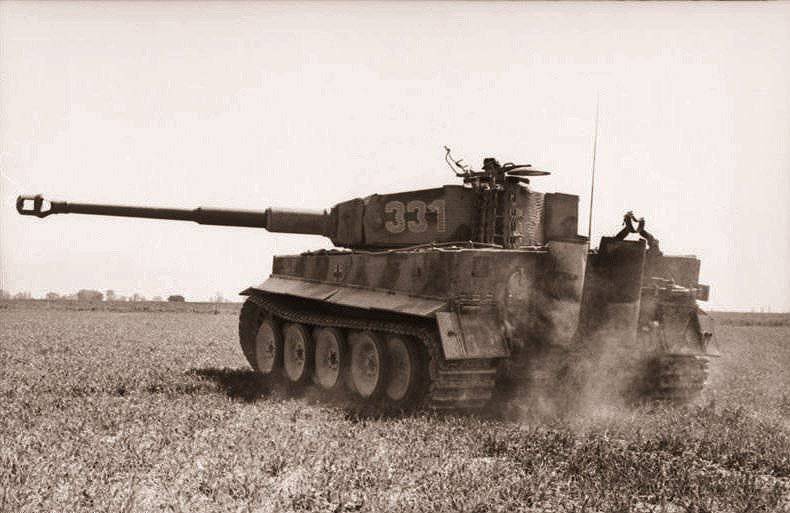
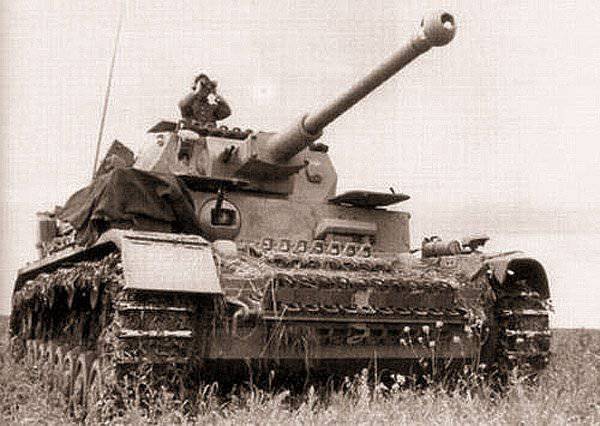
The head of the commander sticking out of the hatch immediately catches the eye. That this is the explanation of the excellent visibility of the German tanks. Almost all the commanders of the German tanks, even in battle, constantly protruded from the hatch and observed the battlefield with binoculars. Of course, they strongly risked getting a sniper fragment or a bullet in the head, but they had no other way out. From inside the tank they could not see anything.
The German tanker Otto Carius commented on this problem: “The tank commanders who batten the hatches at the beginning of the attack and open them only after the goal is reached are worthless, or at least second-rate commanders. There are, of course, six or eight viewing instruments installed in a circle in each tower to provide observation of the terrain, but they are good only for monitoring particular areas of the terrain limited by the ability of each individual viewing instrument. If the commander looks at the left observation device, while the anti-tank gun opens fire on the right, then it will take a long time before he recognizes it from the inside of a tightly closed tank. "..." No one will deny that many officers and tank commanders died from - for sticking your head out of a tank. But their death was not in vain. If they were driving with battened down hatches, then far more people would find their death or be seriously injured in their tanks. Significant losses in the Russian tank forces testifies to the loyalty of this statement. Fortunately for us, they almost always drove over rough terrain with tightly battened hatches. Of course, every tank commander must be careful to look out during a positional war. Especially for the reason that enemy snipers were constantly watching the tower hatches of the tanks. Even if the tank commander poked out for a short time, he could die. I got a folding artillery periscope to protect myself from it. Perhaps such a periscope should have on every combat vehicle. ”[8].
The conclusions of Otto Carius, although close to the truth, are fundamentally erroneous. In the process of describing tanks, I already gave an explanation of what the superiority of the specialized rotating commander observation device in front of the commander's turret with several fixed reticle or periscopic instruments. I will quote myself: “the tank commander for target detection got a quality wide-angle periscopic prismatic MK-4 device which allowed him to continuously trace the entire circular sector with a wide field of view.” “Having rightly decided that the primitive commander's turret with narrow reticle along its perimeter, it is already an anachronism since through these slots is hard to see. A very small sector is seen through each concrete slot, and when moving from one slot to another, the commander temporarily ignores the situation and its landmarks. ”
Otto Carius essentially meant it, forgetting that such a primitive measure as a “folding artillery periscope” carried in a tank, in Soviet cars was in fact already implemented in the form of commanding panoramas and wide-angle, turning, periscopic, observational instruments of the commander.
A few words about the device MK-4. It was not a domestic development, but was a copy of the English instrument MK.IV. Otto Carius’s conclusion that we suffered heavy tank losses due to the fact that our tank commanders did not protrude from the hatch in the battle, of course, is erroneous. The commanders of domestic tanks simply did not need to protrude from the hatches, since they had all the necessary means in the domestic tank for a qualitative survey of the area. The reasons for the great tank losses of the USSR should be sought elsewhere, but more on that below.
Comparison of the characteristics of the sights also does not give grounds to consider the sights of the Soviet tanks as bad. Their design is fully consistent with the world level of the time. Yes, the Germans experimented with stereoscopic sights and optical rangefinders, but such devices did not get widespread then.
Thus, a comparative analysis of tank sights also does not confirm the widespread opinion of their “primitiveness” on Soviet tanks of the Second World War. In some ways Germans were better, in some ways Soviet designs. Domestic tanks were in the lead in stabilization devices, surveillance and sighting systems, one of the first to receive an electric launch of a gun. German tanks were the first in the night vision systems, the perfection of targeting drives and barrel blowing devices after the shot.
But since a myth exists, it means that there was some ground for its emergence. There are several reasons for this point of view. Consider briefly some of them.
The first reason. The main Soviet tank T-34, in which the commander combined the functions of the gunner. The impairment of this type of management is obvious and has been explained more than once during the article. No matter how sophisticated the tank observation devices are, a man cannot even burst. Moreover, the T-34 was the most massive tank of war and purely statistically it was much more “caught” by the enemy. Often the infantry transported on the armor could not help here - the infantry had no connection with the tank crews.
The second reason. The quality of the glass used in the sights. In the most difficult years of the war, the quality of the optics of domestic sights and instruments was very poor for obvious reasons. It deteriorated especially after the evacuation of optical glass factories. Soviet tankman S.L. Aria recalls: “The triplexes on the driver's hatch were completely ugly. They were made from a disgusting yellow or green Plexiglas, which gave a completely distorted, wavy image. Disassembling something through such a triplex, especially in a tank hopping, was impossible. ”[9]. The quality of German sights of this period, equipped with Zeiss optics, was incomparably better. In 1945, the situation changed. Soviet industry brought the quality of optics to the required level. The quality of German sights of this period (as well as tanks in general) at least has not become better. It is enough just to see detailed photos of the “Royal Tiger” to understand that the former “German quality” is no longer there.
The third reason. The difference in the level of training and tactics of warfare. It is no secret that the level of training of German tankers was extremely high. They had enough time to prepare and had tank training grounds, including everything needed for this purpose. In addition, the Germans had considerable combat experience in dealing with enemy tanks. This was combined with the relative freedom of the commanders of German tanks and special tactics of warfare. German tankers were distinguished by the ability to “graze” on the battlefield, that is, by choosing the most convenient positions to wait for their victim.
Even in the offensive, German tanks moved relatively slowly, preferring speed, control over the environment. All this happened with a clear interaction with his infantry and observers. Such tactics of warfare, as a rule, allowed German tanks, if not the first, then at least in time, to detect the threat and respond adequately to it: to open a preemptive fire at the target or to hide in the folds of the terrain.
The closest to this level of training and combat were domestic "elite" heavy tanks such as EC-2. Their crews were staffed only by experienced military personnel with officer positions. Even the loaders had a rank not lower than the foreman. They didn’t rush into attacks at maximum speed, since the EC-2 tank was not necessary (the 122-mm gun didn’t require approaching the target), and the EC-2 did not have the proper speed. Therefore, the tactics of using the heavy tanks of the EC-2 were about the same as those of the Germans and in dueling situations, the EC-2 usually emerged victorious. But with the average T-34, the situation was somewhat different. Their crews were usually soldiers, who of course also learned and knew well the material part of their tanks, but the level of their combat training, however, was significantly inferior to German. In addition, the low power of the X-NUMX-mm F-76 / 32 / ZiS-34 guns required the closest possible approach to the target. All this gave rise to the tactics of attacks at the highest possible speed.
It should be clear to everyone that through unstabilized tank optical observation devices of that time, and even more so through the sighting gaps, only the flickering of the earth and the sky could be seen in the tank jumping over the bumps at a speed of 30-40 km / h. Control over the environment was lost completely. This is typical for any tank of that period and is not a reason to consider the visibility of the T-34 tank as bad. It was used just like that, and aimed shooting was possible only from a place. If Otto Carius or Michael Wittmann were ordered to attack our positions head-on and they would have driven their “Tiger” from the mountain to 40 km / h, then they would not see anything exactly like that (unless of course they went to battle as usual) sticking his head out of the hatch) and we could hardly have destroyed so many of our tanks and SPGs.
Summarizing the final result, I would like to note that the most modern at that time layout and functional scheme of sight-sight instruments was technically implemented on domestic tanks. However, in the most difficult 1942 year of war, the forced tactics of using medium tanks, the poor quality of glass sights and some lag in tank artillery systems (why did powerful 107-mm-6 / -3 / -4 type guns need to be created for the powerful 5-1? for this gun, the usual, already existing KV-1944 with another turret did not fit - only God knows) wiped out these advantages for that period of time. But all these problems were solved by Soviet designers by the XNUMX year.
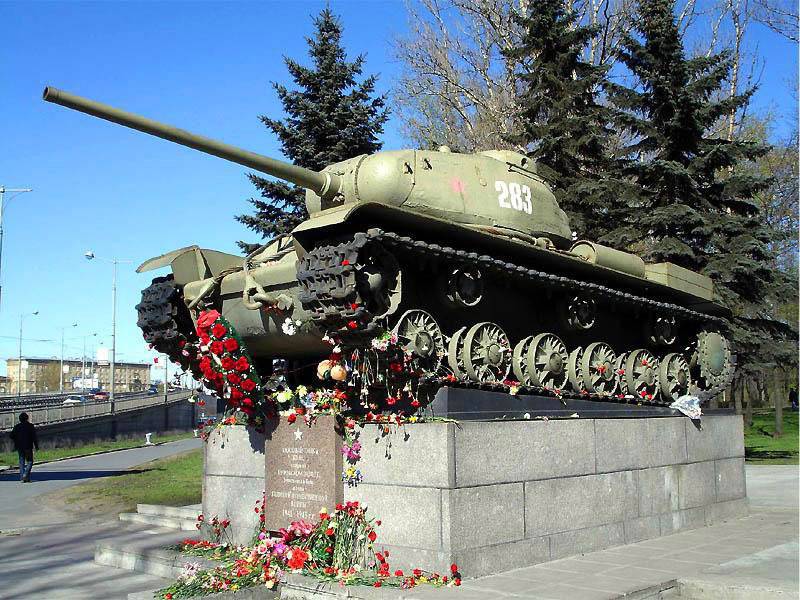
1. "Of stories tests of the T-34 tank ”A. Bakhmetov, G. Kandrashin, Y. Spasibukhov.
2. In the terminology of those years - "headlamp combat light."
3. Direct shot range - the distance at which the projectile on the entire flight path does not rise above the target.
4. "The tank power of the USSR." M. Svirin.
5. The decision was wrong. However, not only the Germans attacked this rake, but also the Japanese created their famous superlinkor “Yamato” and “Musashi”.
6. “Guns of Soviet tanks (1945-1970).” A. Shirokorad.
7. Interview with Oto Lt. Otto Carius.
8. "Tigers in the mud" O. Karius.
9. "I fought on the T-34." A. Drabkin.
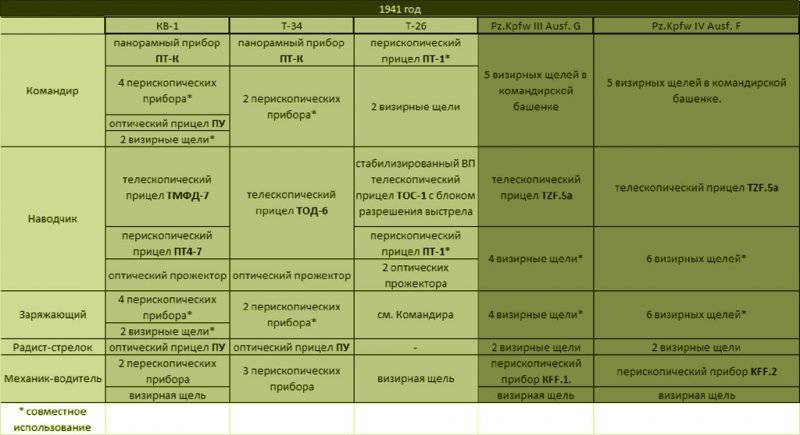
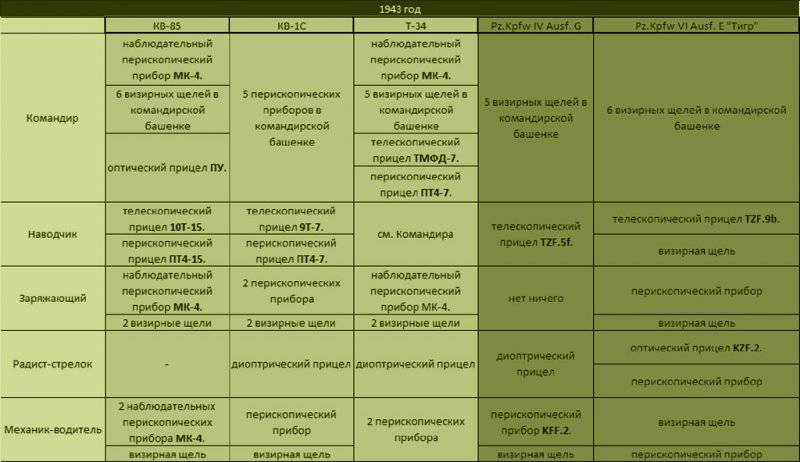
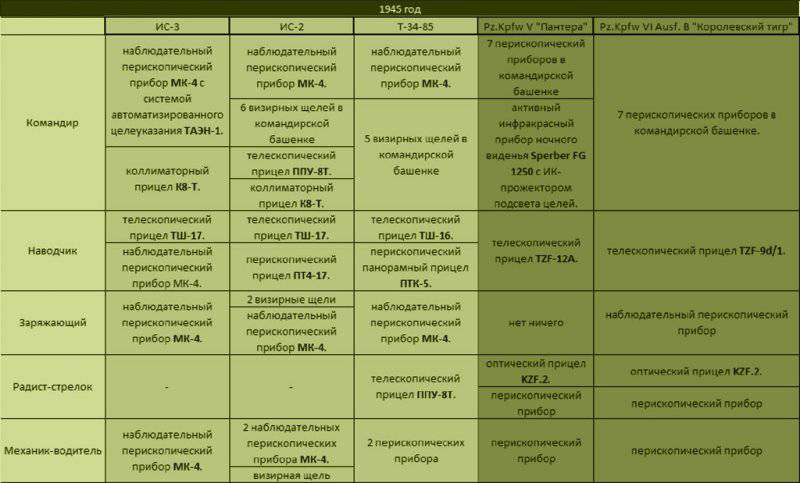


Information